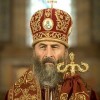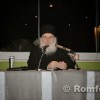Sourse: www.interfax-religion.com 
Deacon Andrey Kurayev, professor at Moscow Theological Academy and well-known Orthodox theologian, sought to dispel some of the myths underlying and referred to in the Da Vinci Code novel, in an interview to Interfax-Religion.
– The stormy campaign around the Da Vinci Code, unexpected but also intriguing for many, has unwittingly put in one’s head the thought about its possible instigators. Simply speaking, qui prodest – who benefits from it?
– The Da Vinci Code is a typical conspiracy work with the principal aim to say that the world is ruled by secret lodges. There is too much fantasy in Brown’s novel. But the very story of its promotion proves the truth of its principal affirmation. Indeed, artistically Mr. Brown’s novel is a clear nil: the cartoon-like protagonists lacking any inner depth and credibility unfold through the plot to fit ultimately in a put-up puzzle. Every action is a clichй adapted to a certain super-goal of propaganda nature. The more so as the book has no academic value.
However, the campaign that advertised first the book and then the film points to very serious funds and resources invested in this project.
The development around the novel can be described as nothing else than another volley fired in ages-old cold war between the Masons and the Catholic Church. It was a real Masonic structure acting in our world that revealed itself in the advertising campaign around Mr. Brown’s book.
I am not one of those who maintain that all that happens around us is linked with the Masons, but I believe it idiotism to ignore the presence of these closed elite structures in the fabric of society beginning from the 18th century to this day. There are open Masonic editions in which they commend themselves and there are openly existing recruit club such as Rotary Club and Lyons Club.
And now we see the ways in which one of the Masonic main goals is realized, and they do not conceal it. It is marginalization of the traditional Christian Church. The apologists of the Da Vinci Code have used all possible places including the Cannes Film Festival stair carpet to try to assure everyone that the book is a mere light fiction.
If it is a fiction, everyone is free to fantasize at will. But the Da Vinci Code commends itself from the first page as a research work. Already the third paragraph on the first page maintains that ‘all descriptions of artwork, architecture, documents, and secret rituals in this novel are accurate’.
But opening the page with a description of Leonardo da Vinci’s Madonna of the Rocks, we read: ‘Mary was holding one hand high above the head of infant John and making a decidedly threatening gesture – her fingers looking like eagle’s talons…’ How can it be an objective and credible description of Leonardo’s painting? It is enough to look at the bright Image of Mary on this canvas to realize she was not going to ‘threaten’ anybody with ‘talons’.
By the way, Brown (perhaps following the tradition of Mexican soup-operas) confused the babies: Mary’s hand is hanging in a protective gesture over the head of Jesus. This baby is clearly smaller than the one embraced by Mary, as Jesus was junior to John by half a year, and the London’s version of the same painting features a tall cross-like staff in the hand of the Precursor, pointing clearly who is where. Langdon therefore is wrong to wonder why Da Vinci’s ‘baby John was blessing Jesus… and Jesus was submitting to his authority’.
Equally biased is the description of the Last Supper. In the original, Peter’s hand simply lies on John’s shoulder in an encouraging gesture. In the Code, John is identified with Mary Magdalene.
– And what about the description of documents?
– The ‘Grail’ of the novel represents ‘thousands of ancient documents as scientific evidence that the New Testament is false testimony’. We read on, ‘the Bible represents a fundamental guidepost for millions of people on the planet, in much the same way the Koran, Torah, and Pali Canon offer guidance to people of other religions’. Let us forgive him a popular amateurish mistake of opposing the Bible and the Torah. But what is this holy Pali Canon? Pali is the language in which some of the Buddhist texts are written. Brown’s protagonists are skilled in identifying and interpreting allegories. But in spite of their Gnostic statement that ‘religious allegory has become a part of the fabric of reality’, they are inclined to understand ‘Jesus’ kisses’ more than literally.
The funniest thing in Brown’s book from the point of view of a religious researcher is an attempt to present early Christian heretics (Gnostics), who wrote the ‘Gospels’ he refers to as those who look benevolently at the world, flesh, marriage, sex, woman. In reality the Gnostics just as neo-Platonic heathens were ashamed of their corporal nature. The key affirmation of the ‘Gospel of Judas’ so much boosted by the ‘Priory of Sion’ is that ‘cosmos is hell’. We read in the ‘Gospel of Thomas’: ‘He who has found the world has found a corpse’.
A similar garbling is used by this author when he alleges that Gnostics and their apocrypha asserted the human nature of Christ, contrary to the orthodox who deified Christ. Quite the contrary, the Gnostic ‘Gospels’ say almost nothing about the earthly life of Christ (not all the apocrypha are written by Gnostics; some, exactly those which give more biographical details, have their origin in folklore). The principal affirmation made by the Da Vinci Code in religious research is that Christianity has borrowed all its ideas and symbols from heathenism. This idea was very much in fashion in the 19th century, but modern religious research, including secular studies, no longer believes that. The principal idea of Christianity is that the One Pre-Eternal God, the Creator of the Universe, became Man precisely freely, for His love of human beings, not for the sake of solving some inner problems and intrigues, and He sacrificed Himself for the sake of human beings.
Another typical educational Masonic idea, which was long rejected even by atheistic religious studies, is that the entire evolution of religion is realization of the will to power, and that the clergy elaborate a doctrine in their own self-interest. Here again we arrive at a contradiction. If everything in Christianity has been borrowed from heathenism so bright and feministic, why then Christianity has come out so ‘dark’? Is it possible that heathen sages and priests pursued their own self-interests when they created their ‘symbols of the feminine principle’?
A lot of affirmations in the Da Vinci Code are easily refuted by an address to primary sources and academic publications.
Brown maintains that for the three centuries of hunting witches the Inquisition burnt five millions women, including midwives. With these quantities it is strange that there is anybody at all remaining in Western Europe.
Another Brown’s ‘credible’ allegation is that the First Ecumenical Council decided which Gospels were to be considered authentic and which imaginary. But no sources of the 4th century mentioned anything to this effect. Nor any of the 5th century sources mentioned that.
The version that it was the Council of Nicea that established the biblical canon was first voiced in Lebellus synodicus published in 1601 by John Pappus, a theologian in Strasbourg. It is evident from this that he was in no way a contemporary of the 325 Council. The work of Mr. Brown abounds with strained arguments of this kind – the fact that does not allow of taking it as scientifically correct in the least. But the publicity around the Code is built on the kaleidoscope of mutually exclusive assurances. Thus, at one point it is said all of a sudden that the book is ‘a pure fiction, so do not scold us’, but a moment later the same advertising agents begin to pontificate that Brown has finally established the great truth and we now know the truth about Christianity.
– Your greatest surprise when reading the novel?
– The absence of the Masonic fable about a Church council that was allegedly held in antiquity to discuss with all the seriousness whether woman should be considered to be human being or not and to adopt by a one-vote majority the presence of soul in ‘old women’ as well. It is the favorite Masonic feministic fable. Strangely, Brown did not play with it. Perhaps he is yet an apprentice. He is lacking erudition or saving this trump card for his next novel.
I was also surprised at the somewhat childish codes. As I was reading the book I found four clues on my own, while Langdon was still toiling over them.
– What reaction to the story of the Da Vinci Code you think would be the most adequate and successful?
– A scientific analysis of some pages from Brown would be quite relevant and it is not difficult to make it. An analysis will show immediately that before us is a poor fiction which set itself the task to insult the faith of millions of people in the world. And this is exactly the falsehood of the so-called fiction. Picket lines at movie theatres will not be helpful. Those who have decided to stand in them will do it anyway. The picket lines will rather attract those who are indifferent. It would be better to commission an analysis of Brown’s book to religious researchers and theologians and to publish a leaflet, or even better a parody, and to distribute their copies at movie theatre entrances. I would suggest this title for the leaflet: ‘Brown-anti-duping Aid’.
Alexy II: showing the Da Vinci Code a manifestation of disrespect for ethical normsMoscow, May 30, Interfax – The distribution of the Da Vinci Code film is disrespect for ethical norms pointing to the fact that Europe has lost its Christian roots, stated Patriarch Alexy II of Moscow and All Russia. ‘The notorious ‘cartoon scandal’, which provoked an upsurge of violence everywhere and led to numerous victims, the story of the Swedish pastor imprisoned for his protest against homosexuality, the distribution of a film shot after Dan Brown’s novel, insulting for Christians – all these are vivid examples of disrespect for the traditional norms of morality under the guise of protection of freedom’, the patriarch said during his meeting with Slovenian Prime Minister Janez Jansa on Tuesday in Moscow. ‘One cannot but feel concerned seeing how the Christian identity of European nations is being obliterated’, the primate added. He is convinced that a Europe which has lost its bonds with Christianity ‘would not be able to meet the challenges brought about by the modern world’, Alexy II stressed. He also noted that the modern concept of human rights should be based on morality. ‘In our concern for human rights we should not forget about moral traditions. Stability and world order should be based on respect for people’s convictions and their way of life’, he said. The patriarch also stated that the Russian Church supported the idea of inter-cultural and inter-religious dialogue in Europe, which he believes is a guarantee of ‘reinforcement of security and stability in today’s world’. ‘We are strongly against terrorism, extremism, radicalism, regardless of the ideas they may use for cover’, the primate added. |
















